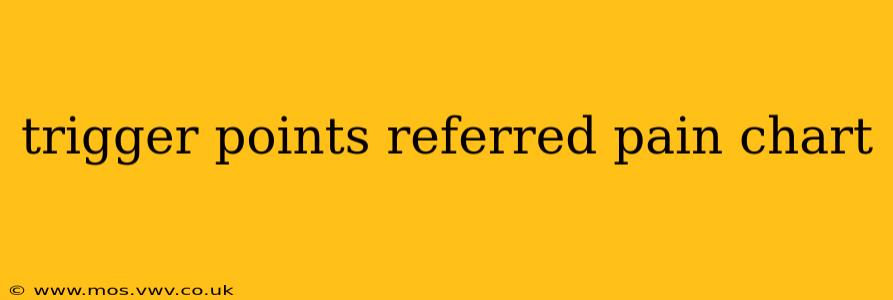Understanding referred pain is crucial for anyone suffering from muscle pain. A trigger point, a hyperirritable spot in a taut band of skeletal muscle, can cause pain not just in the immediate area but also in distant locations. This phenomenon, known as referred pain, can make diagnosing the source of discomfort challenging. This article will explore the concept of trigger points and their associated referred pain patterns, utilizing a virtual "chart" approach to illustrate common patterns. While a detailed anatomical chart would require visual aids, we'll describe these patterns in detail.
What are Trigger Points?
Trigger points are small, hyper-sensitive knots within a muscle. They develop when muscle fibers contract involuntarily and remain shortened, leading to a localized area of increased tension and pain. Palpating a trigger point often elicits a noticeable tenderness or jump sign (a reflexive muscle contraction). The exact mechanisms behind trigger point formation are still under investigation but are believed to be linked to muscle overload, repetitive strain, poor posture, and stress.
How Does Referred Pain Work?
The exact mechanism of referred pain from trigger points isn't fully understood, but several theories exist. One prominent theory suggests that the convergence of sensory nerve fibers from different areas of the body onto the same neuron in the spinal cord plays a critical role. Essentially, the brain receives signals from the trigger point and misinterprets their origin, leading to pain perceived in a distant location.
Understanding the "Virtual" Referred Pain Chart
Instead of a visual chart, let's explore common referred pain patterns associated with various muscle groups. Remember that the pain intensity and exact location can vary from person to person.
Common Trigger Point Referred Pain Patterns:
1. Upper Trapezius: Pain often radiates to the head and neck, sometimes extending to the shoulder and upper arm. This is a very common pattern, particularly for those who spend prolonged periods sitting at a desk or looking down at screens.
2. Suboccipital Muscles (Base of the Skull): Referred pain is often localized in the back of the head, extending upwards to the top of the head, forehead, and even behind the eyes. Tension headaches are often associated with trigger points in this area.
3. Temporalis Muscle (Side of the Head): Referred pain commonly extends to the temple area, cheek, and even the upper jaw, potentially contributing to temporomandibular joint (TMJ) disorders.
4. Masseter Muscle (Jaw): Referred pain often focuses on the jaw, ear, and temple, and can mimic symptoms of TMJ dysfunction.
5. Levator Scapulae (Upper Back/Neck): Referred pain can spread across the upper back, around the shoulder blade, and up into the neck and base of the skull.
6. Pectoralis Minor (Chest): Can radiate pain towards the anterior chest, shoulder, and inner arm, sometimes extending down the inner arm to the hand.
7. Gluteus Maximus (Buttocks): Pain can radiate down to the back of the thigh and buttock, sometimes mistaken for sciatica, though it's distinctly different.
8. Piriformis (Buttock): This small muscle can cause pain in the buttock, radiating down the posterior thigh, often confused with sciatica. The pain can be particularly intense with prolonged sitting.
9. Lateral Gastrocnemius (Calf): Pain is frequently felt in the lateral calf but can also radiate into the lateral ankle and foot.
What to Do About Trigger Point Pain?
If you suspect you have trigger points, it's crucial to consult a healthcare professional. Self-treatment may worsen the condition. Treatments may include:
- Physical Therapy: A physical therapist can identify trigger points and guide you through stretches, strengthening exercises, and other techniques to alleviate pain and improve muscle function.
- Dry Needling: This technique involves inserting thin needles into trigger points to release tension.
- Massage Therapy: Massage can help to break up muscle knots and improve blood flow.
- Heat and Ice: Applying heat or ice can help to soothe muscle pain and inflammation.
This information is intended for educational purposes only and should not be considered medical advice. Always consult with a qualified healthcare provider for any health concerns or before making any decisions related to your health or treatment.
